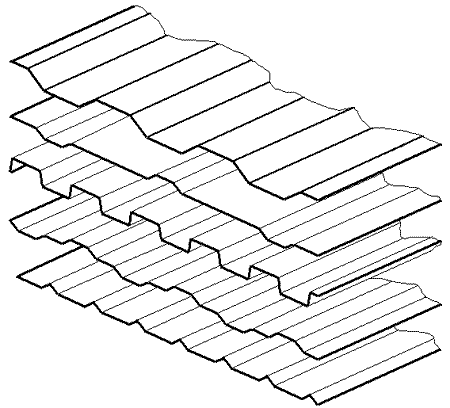|
This section is about:
Why Corrugated Plates ?
A corrugated plate is an example of a 3-dimensional or space structure.
Corrugated plates have enhanced resistance against horizontal and vertical
loads. To consider the effectiveness of corrugated plate look at the
following experiment.
Enhanced horizontal resistance
|
|
When a thin sheet of steel rests between two supports
it will bend due to the fact that it has insufficient strength to
carry its own weight. |
|
If the same piece of steel is corrugated then
it will be capable of supporting one hundred times its own weight.
|
|
|
|
If the load is increased past this point then the
structure will fail and the corrugations will flatten out. |
|
This problem can be rectified by using transverse
stiffeners at the ends. The corrugated plate acts as a beam and
can support even greater loads.
|
|
Enhanced vertical resistance
|
|
When a thin sheet of steel is stressed to a vertical
load, the plate will bend due to the fact that it has too less capacity. |
|
The profiling of the plate avoids failure, due
to enhanced resistance against vertical loads.
|
|
Corrugated Plate dimensions
| The figure below shows our standard corrugation. Other dimensions
are also possible. Please contact us. |
|
|
Our patented production process doesn't require moulds
and therefore we are able to manufacture all dimensions between module
500 mm and 1000 mm. In our standard configuration the angles are 45
º. But angles of approximately 70 º can also be achieved.
Our corrugated plates are unlimited of length. The plates have no theoretical
limitations in the number of folded modules.
The folded modules have to be transported, so in practice the lengths
are ranging between 6 m and 18 m.
Corrugated Plate shapes
| |
| There are several varieties of corrugation shapes.
All shapes which continuously repeat can be manufactured by GLP.
The only condition is a maximum depth of 240 mm. |
|
Corrugated Web Beams
A Corrugated Web Beam or a GLP Beam is a built-up
girder with a thin-walled, corrugated web and plate flanges. The
profiling of the web avoids failure of the beam due to loss of
stability before the plastic limit loading of the web is reached.
Engineers have long realized that corrugations in webs enormously
increase their stability against buckling and can result in very
economical designs. Therefore, Corrugated Web Beams have
the potential to eliminate many costly web stiffeners. In addition,
the use of thinner webs results in less raw material cost with
savings estimated at 10-30% compared with conventional built-up
sections and more than 30% compared with standard I-beams.
The optimum area of application is in steel structural engineering
wherever rolled profiles of structural height greater than 800
mm or lattice girders above 1500 mm were formerly used.
Within the subject of girders there are again many applications.
For fatigue applications such as bridges etc., it is thought
that sinusoidal corrugations are better than trapezoidal
corrugations. This is not the case for GLP corrugated plates.
GLP is able to bend the plates with a radius/thickness rate greater
than the number 5.
|
| |
| |
| |
| |
| |
|
|
| |
| |
| |
| |
|
|
Applications
Corrugated web beams are manufactured to meet the markets highest requirements.
The beams and the corrugated plates are suitable as:
- supports and columns
- steel retaining walls
- transportation structures (such as the side panels of trains, containers
and trucks)
- feed silos
- cranes
- double-hulled ships
|
|
Hybrid Construction
The aim is to take advantage of different materials. The concrete
is used for the deck and the bottom slab. The webs have only to
connect the cross section and to transfer the transverse forces.
For this a corrugated plate is used.
|
|













